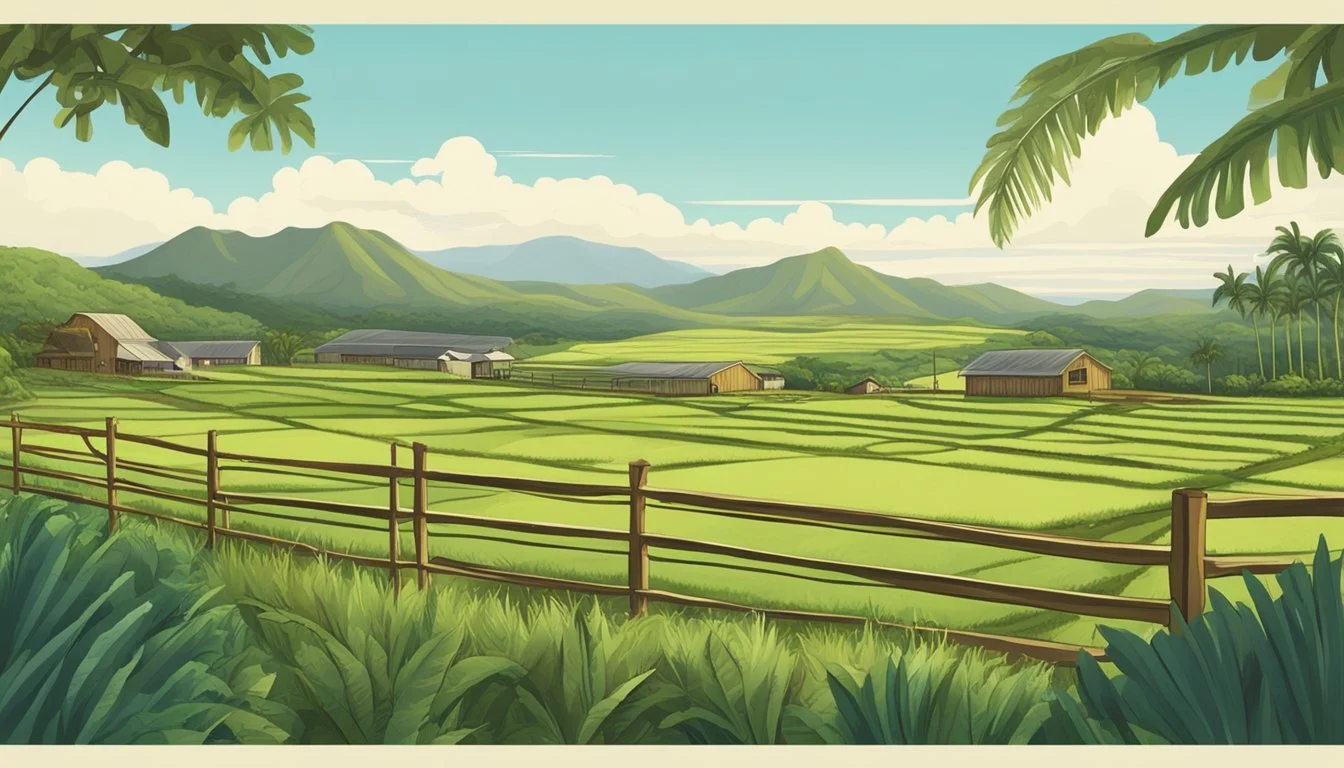Right to Farm Law in Hawaii
Understanding Agricultural Protections
Hawaii's Right to Farm Law serves as a foundational piece of legislation aimed at safeguarding the agricultural sector from nuisance lawsuits and the predations of non-farming land development. Enacted by the legislature, this law underlines the importance of agriculture to the state's economy and cultural heritage. It establishes the legal framework that protects farming operations conducted in accordance with generally accepted agricultural and management practices from being deemed nuisances.
The law is a recognition of the challenges faced by farmers from urban encroachment and changing land use patterns. By enshrining a right to farm in state statutes, Hawaii asserts a public policy that acknowledges farming as a vital activity deserving protection and encouragement. The law's provisions aim to ensure that farms can operate without the undue threat of litigation that can arise when new residential developments encroach on traditional farming areas.
Key components of the law include defining what constitutes a farming operation, the conditions under which farming is protected, and the approach to handling frivolous lawsuits against farms. These measures collectively contribute to a legal environment in which agriculture can continue to flourish, promoting food security and the sustainability of rural communities across the Hawaiian Islands.
Historical Context of Right to Farm Laws
Right to Farm laws serve to protect agricultural activities from nuisance lawsuits as urban development encroaches upon rural areas. These laws provide a framework for balancing the needs and rights of farmers with those of neighboring communities.
Origins and Evolution
Right to Farm laws originated in the United States in response to the growing conflicts between agricultural and expanding urban and suburban areas. As residential developments progressed into traditional farming regions, farmers increasingly faced nuisance lawsuits from new neighbors unaccustomed to the realities of agricultural operations. To safeguard farmers and ensure the continuance of agricultural production, states began implementing Right to Farm statutes. These laws have evolved over time, shaped by state-specific agricultural concerns and the dynamics between farming communities and urban growth.
Hawaii Revised Statutes
In Hawaii, the Right to Farm Act is embodied within Chapter 165 of the Hawaii Revised Statutes. The act was established in 1982 to offer legal protection to farms, ensuring that they could continue operations without the undue interference of nuisance claims. The statutory framework sets out clear conditions under which agricultural operations are protected, such as:
The farming operation must not have been a nuisance when it began.
It must lawfully operate for at least a year prior to the nuisance claim.
Changes in surrounding land use occurring after the establishment of the farm could further entrench its protection against such claims.
Notably, Hawaii's definition of a "farming operation" is inclusive, recognizing aquaculture along with traditional forms of agriculture as deserving of protection under these laws. Indeed, the Right to Farm laws in Hawaii reflect the state's unique agricultural landscape and its commitment to preserving its longstanding farming operations against the pressures of modern development.
The Hawaii Right to Farm Act
The Hawaii Right to Farm Act, Chapter 165 of the Hawaii Revised Statutes, establishes and protects the rights of farmers and agricultural operations within the state.
Findings and Purpose
Section 165-1 of the Act acknowledges the importance of agriculture to the economy and environment of Hawaii. It recognizes that farms need legal protection to produce food and other agricultural products sustainably and efficiently.
Declaration of Public Purpose
The declaration of public purpose, as outlined in Section 165-3, explicitly states Hawaii’s commitment to preserving and encouraging agricultural and farming activities. The Act designates these activities as beneficial to the public welfare and therefore worthy of protection.
Definitions and Scope
Key definitions critical to understanding the scope and application of the Act are found in Section 165-2. Terms such as "farming operation" and “nuisance” are clarified here. The Act applies broadly, ensuring that farming operations conducted in accordance with generally accepted practices are safeguarded.
Protection for Farming Operations
In Hawaii, Right to Farm laws offer clear protections for farming operations, aiming to preserve agricultural activity by shielding farms from certain types of legal challenges and promoting accepted farming practices.
Protection from Nuisance Lawsuits
Hawaii’s Right to Farm Act is designed to protect lawful farming operations from nuisance lawsuits under specific conditions. The key aspects of this protection include:
Operation History: A farming operation must not have been a nuisance when it began.
Changes in Surroundings: Protection is provided if the nuisance claim arises after changes occur around an established farming operation.
Duration: The operation must have lawfully conducted its activities for at least one year before a nuisance claim is brought forward.
In accordance with these conditions, a farming operation may operate without the threat of being deemed a nuisance solely due to changes in the area around it, reflecting a respectful balance between agriculture and urban development.
Allowed Agricultural Practices
Right to Farm laws in Hawaii explicitly recognize the significance of standard agricultural practices. For a farming operation to be shielded from nuisance designations, it must adhere to the following:
Consistency with Accepted Practices: Operations must follow generally accepted agricultural and management practices. This clause ensures that as long as farms comply with such standards, they cannot be considered a nuisance.
Liberal Construction: The law is to be liberally construed to allow the continuation or expansion of agricultural facilities and activities. This liberal construction signals Hawaii’s legislative intent to protect and encourage farming as a vital part of the local economy and culture.
By endorsing these practices, Hawaii's laws facilitate a conducive environment for agriculture to thrive, supporting the sector’s economic and cultural contribution to the state while maintaining legal safeguards for farmers.
Legal Challenges and Support
Hawaii's Right to Farm laws are designed to offer a robust legal framework that supports agricultural activities, efficiently separating legitimate claims from those deemed meritless, with specific provisions to handle court challenges.
Rebuttable Presumption in Court
In court, rebuttable presumption serves as a powerful tool for farmers. This legal principle works in favor of agricultural operations by presuming agricultural practices are not a nuisance if established prior to surrounding non-agricultural activities. To overturn this presumption, plaintiffs must present clear evidence demonstrating that the farm practices are indeed unreasonable and constitute a legitimate nuisance.
Dealing with Frivolous Lawsuits
The law offers protection against frivolous lawsuits aimed at farming operations. This safeguard exists to deter legal action with no substantial merit, often intended to disrupt or burden the agricultural operations. It allows courts to dismiss unfounded lawsuits swiftly and requires plaintiffs who bring such lawsuits to pay the attorney fees and court costs incurred by the farm operators. This protection is pivotal in encouraging investments in agriculture and preserving farming as a viable and essential part of Hawaii's economy and community.
Impact on Local Communities
The Right to Farm Law in Hawaii directly influences the interactions between agricultural practices and local communities, particularly concerning nuisance suits and land use.
Public Support and Opposition
The Hawaiian public shows diverse reactions to the Right to Farm laws. Supporters argue that these laws protect vital farming operations, ensuring that agriculture can continue to flourish without undue legal pressures. On the other hand, opposition often comes from residents who are concerned about potential negative impacts on their living conditions, including issues related to smell, noise, and pest management. Each county, including Kauai and Honolulu, has its unique demographic and environmental context, which shapes the local public's stance on such legislation.
Effect on Landowners and Residents
For landowners, the Right to Farm Law can be seen as a safeguard that allows them to operate without the fear of encroaching urban development and associated complaints. This legal protection often includes a condition where the farming operation must not have been a nuisance when it began, thus implying a mutual adaptation between the farms and the surrounding communities.
Residents in these areas, especially in places like Honolulu, where the pursuit of Important Agricultural Lands designation seeks to strengthen agricultural presence, may experience new dynamics in their vicinity. Some counties might impose additional restrictions to balance the needs of the residents with those of the farmers. Consequently, the law can alter the landscape of property rights and community relations.
Farming and Environmental Concerns
In Hawaii, Right to Farm laws safeguard agricultural practices while ensuring responsible stewardship of the environment. This balance is crucial for maintaining the health of both the farming industry and the natural ecosystem.
Managing Dust, Noise, and Odor
Farm operations generate dust, noise, and odors which can affect surrounding communities. To mitigate such impacts, farmers utilize practices like windbreaks to control dust, sound barriers and restricted hours of operation to manage noise, and odor control plans for livestock and manure management. These strategies help maintain the quality of life for nearby residents and preserve the tranquility of the rural environment.
Water Usage and Soil Conservation
Water is a precious resource in Hawaii, and agricultural activities require efficient usage to sustain both crop production and environmental health. Techniques such as drip irrigation and rainwater harvesting are employed to conserve water. Soil conservation methods, including crop rotation, cover crops, and contour farming, prevent erosion and loss of topsoil on farmland, preserving the soil's fertility and preventing sedimentation in waterways.
Use of Chemical Fertilizers and Pesticides
The use of chemical fertilizers and pesticides in farming is a matter of concern due to potential pollution risks. Farmers must adhere to stringent regulations that govern application rates and methods, to avoid runoff that could harm surrounding ecosystems. Integrated Pest Management (IPM) systems are implemented to reduce the reliance on these chemicals, focusing instead on natural and sustainable alternatives.
Regulation and Zoning
In Hawaii, the regulation and zoning of agricultural lands are tightly controlled to balance the needs of farming activities with community interests. The state's Right to Farm Act and local zoning rules are key in maintaining this balance.
Zoning Criteria for Agricultural Lands
Hawaii classifies agricultural lands based on the Land Study Bureau’s detailed land classification. Specifically, lands with a productivity rating of Class A or B are highly regulated to ensure permissible uses within the agricultural districts. This classification system serves to protect and preserve the lands that are most suitable for agricultural productivity, which is instrumental in the state’s agricultural plan.
State Law vs. Local Regulations
While the Hawaii Right to Farm Act establishes a foundational layer of protection for farming operations, local regulations—including those enacted by Honolulu—can complement or specify these provisions. The Act protects farming operations by setting conditions that must be met to receive protection from nuisance claims. For example, a farm can't be declared a nuisance if it wasn't one when it began, and if it has been in lawful operation for at least a year prior to the nuisance claim. In contrast, local zoning rules might impose additional restrictions, such as those on farm dwellings and employee housing on important agricultural lands (IAL). These local rules provide a more granular level of control that works alongside the state law to address the unique needs and concerns of individual communities across Hawaii's diverse islands.
Economic and Cultural Significance
Hawaii's Right to Farm Law holds profound implications for the state's economy and the cultural fabric of its farming communities. It underpins the agriculture sector's viability, ensuring the farms' endurance amidst expanding developmental pressures and undergirding the tourism industry that thrives on Hawaii's pastoral allure.
Sustainable Agriculture and Tourism
Hawaii’s agricultural sector is crucial to its economy, contributing significantly through the production of various crops. Sustainable agricultural practices have become integral, not only for the economy but also for maintaining the natural beauty that attracts tourists. Tourism, a cornerstone of Hawaii's economy, and agriculture are intertwined. Visitors are attracted by Hawaii's lush farmlands and the opportunity to experience the local food culture, which includes coffee plantations, macadamia nut farms, and tropical fruit orchards.
Economic Impact
Agriculture: Pivotal in diversifying Hawaii’s economy beyond tourism.
Tourism: Enhanced by visitors seeking agritourism experiences.
Cultural Impact
Agricultural tourism supports the preservation of local farming techniques.
Visitors gain a deeper understanding of Hawaii's sustainable practices.
Cultural Heritage of Farming in Hawaii
The cultural heritage of farming in Hawaii extends beyond mere cultivation; it represents the legacy and resilience of its communities. Farming is entrenched in the Hawaiian way of life, embodying the principle of Aloha ‘Āina—love of the land. This deep respect for land stewardship, passed down through generations, is safeguarded by the Right to Farm Law, which recognizes the cultural and historical significance of indigenous and local agricultural practices.
Native Farming Practices
Integral to preserving Native Hawaiian culture.
Essential for the perpetuation of traditional crops, techniques, and historical lands.
Community Identity
Farming fortifies community identity and self-reliance.
Strong agricultural roots manifest in community festivals, markets, and education.
Advancing Farming Practices
Hawaii's agricultural sector is embracing advancements to ensure the sustainability and productivity of its farming operations. The following discusses how innovations and technology are integral to this progress.
Innovations in Livestock and Crop Production
In the realm of livestock production, Hawaiian farmers have implemented a range of innovative techniques to enhance animal welfare and output. Selective breeding practices have improved genetic lines for both resistance to local pests and diseases and increased productivity. Additionally, sustainable grazing systems have been employed to optimize land use while maintaining soil health.
Crop production has seen a shift toward resilient crop varieties, developed through both traditional breeding methods and new scientific approaches like genetic modification. These varieties are designed to withstand Hawaii's unique climatic challenges such as high humidity and occasional droughts. Furthermore, farms are increasingly adopting cultivation practices that reduce erosion and improve water retention, like cover cropping and reduced tillage.
Technology and Farming Efficiency
Rapid advancements in technology offer Hawaii's farmers tools to significantly increase efficiency. Precision farming has become more prevalent with the use of GPS-guided machinery, allowing for meticulous planting, fertilizing, and harvesting. This level of precision minimizes waste of resources and optimizes crop yields.
Irrigation has always been an essential aspect of farming in Hawaii, and modern irrigation pumps managed by smart systems can now adjust water distribution based on real-time data, resulting in less water usage and lower costs. The integration of sensors and automation helps in monitoring crop health, soil conditions, and water levels, ensuring resources are utilized economically and effectively.
Farmers have integrated state-of-the-art machinery which is more fuel-efficient and produces fewer emissions, reflecting a commitment to environmental responsibility alongside operational productivity. These technologies collectively create a progressive and forward-thinking agricultural environment in Hawaii, where farming practices continually evolve in response to an ever-changing world.
Education and Outreach
In ensuring the success of Hawaii’s Right to Farm laws, a strong focus is placed on education and outreach. The goal is to provide the public with accurate information and involve the community in agricultural education efforts.
Providing Accurate Information
Email Communications: A primary method used to distribute accurate information regarding the Right to Farm laws in Hawaii is through targeted email campaigns. These campaigns are designed to inform residents about the protections provided to farmers and the importance of these laws in sustaining local agriculture.
Educational Materials: Agencies create materials such as brochures, fact sheets, and comprehensive guides. These resources are accessible to the public and detail the rights of farmers, the significance of agriculture to Hawaii's economy, and how these laws impact the community.
Community Engagement and Education
Agricultural Education in Schools: The Hawaii Farm to School Program is an initiative designed to incorporate agriculture into the educational curriculum. This effort fosters an understanding among students of farming practices, local food systems, and the environmental benefits of supporting local agriculture.
Public Workshops and Seminars: Regularly conducted workshops and public seminars act as platforms for direct engagement with the community. These events serve to educate the public about the intrinsic value of farming and the protection measures under the Right to Farm Act.
By focusing on providing accurate information and engaging the community through education, Hawaii's Right to Farm laws are demystified for the public, ensuring a harmonious relationship between agricultural operations and surrounding communities.
Governance and Legislation
Legislation governing agriculture in Hawaii is thorough, with the Hawaii Right to Farm Act codified as Chapter 165 of Title 11, focusing on agriculture and animals. This framework is pivotal in maintaining the balance between agricultural practices and the expansion of urban development.
The Role of the Legislature
The Hawaii State Legislature holds the critical responsibility of crafting and enacting laws that pertain to agriculture within the state. It primarily oversees the creation and modification of statutes within Chapter 165, which articulate the protections and regulations surrounding farming operations. These laws are designed to safeguard farmers from nuisance lawsuits, thus allowing agricultural activities to persist without unwarranted disruption.
Enacting Bills and Amendments
When the need arises to introduce new legislation or amend existing laws, bills are proposed and reviewed by the legislature. An example is House Bill 2506, which addresses concerns of urban encroachment on agricultural lands. The rigorous legislative process ensures that any changes to the Right to Farm laws, including adjustments to Title 11, are thoroughly vetted and serve the interests of both the agricultural community and broader public policy objectives.
Conclusion
Hawaii's Right to Farm Act stands as a shield for agricultural operations, ensuring that farms that adhere to accepted practices can operate without the fear of nuisance lawsuits. These protections are critical for the sustainability and viability of the farming industry in the state.
Key points:
Farming operations are protected if they follow legally recognized and generally accepted agricultural practices.
There must be proof that the farming operation was not a nuisance since its inception and that any claims arise only after a year of lawful operation.
Farmers are thereby afforded a certain degree of certainty and encouragement to engage in agriculture. Furthermore, Hawaii's approach reflects a commitment to preserving agricultural land and supporting the farming community, which is vital for the state's economy and food production capabilities.
It is recognized, however, by lawmakers and communities alike that agricultural practices must be balanced with environmental and public health concerns. As such, the legal framework offers a rebuttable presumption in favor of the farm operation, allowing for due process and fair examination of any nuisance claims.
In summation, Hawaii's Right to Farm Act embodies a deliberate effort to nurture an environment conducive to farming while attempting to harmonize the various interests of stakeholders. Through continued evaluation and potential refinement of the Act, an equilibrium that honors both the agricultural heritage and the evolving dynamics of Hawaii's rural landscape can be sustained.











